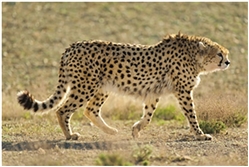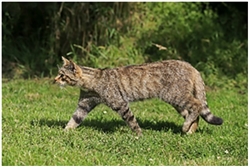We love cats
Cats (Felidae) belong to a family of 40 species within the order Carnivora. Cats are strictly carnivorous, with specialised adaptations for hunting, and are often found at the top of food webs.They usually ambush their prey rather than chase it over a long distance like the Canidae (dog-like family). In poor light their vision is up to six times better than ours: many species are crepuscular or nocturnal (active at dawn and dusk or during the night).
Although cat species have broadly similar features, they have managed to adapt to all terrestrial habitats except treeless tundra and polar ice caps. Native populations can be found on every continent except Antarctica and Australia; they are absent from Madagascar, Japan and most oceanic islands. However, domestic cats can be found almost everywhere that is inhabited by humans.
The main threats to cat populations are habitat loss and fragmentation; hunting for sport, the pet, fashion and traditional medicine industries; and farmers killing them because they may threaten their livestock. Conversely, their existence contributes to ecotourism in Africa and India so this affords them some protection.
IUCN extinction risk categories www.IUCNredlist.org
NE not evaluated
DD data deficient
LC least concern
NT near threatened
VU vulnerable
EN endangered
CR critically endangered
EW extinct in the wild
EX extinct
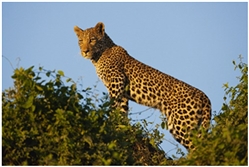 |
Leopard (Panthera pardus) VU
Of all the old world cats, leopards are found in the widest range of habitats: from desert and savanna grasslands to mountains and rainforests, across Africa and Asia. Leopards may hoist their prey into a tree to prevent it from being stolen.
(Image Credit 00000-00478134 Theo Allofs/Minden Pictures/FLPA)
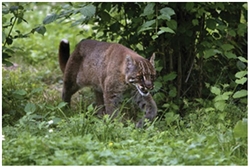 |
Asiatic Golden Cat (Catopuma temminckii) NT
This cat is usually found in various types of forests but has also been recorded in more open areas. It’s fur is usually golden or red brown but can also be dark brown, grey and even spotted; its most distinctive feature is the ‘stripes’ on its face.
(Image credit 4b10214-00017-235 Sebastian Kennerknecht/Minden Pictures/FLPA)
 |
Jaguarundi (Herpailurus yaguarondi) LC
The jaguarundi is usually found in both open and closed habitat near running water in Mexico and South America. They are slightly larger than a domestic cat at 5kg but not related to jaguars, as their name suggests, rather pumas and cheetahs.
(Image Credit 10608-00019-235 Gerard Lacz/FLPA)
 |
Flat-headed Cat (Prionailurus planiceps) EN
This small cat is usually found in freshwater wetlands in parts of Malaysia and Indonesia. It has longer and sharper teeth than its close relatives which help it grip slippery fish and its toes are more completely webbed than even the fishing cat’s (Prionailurus viverrinus).
(Image Credit 55551-19520 Alain Compost/Biosphoto/FLPA)
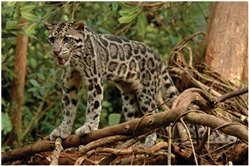 |
Sunda Clouded Leopard (Neofelis diardi) VU
The Sunda clouded leopard is found in various types of forest in Sumatra and Borneo. Their short legs and wide paws help them to climb trees, whilst their exceptionally long tail helps them balance when travelling through the canopy.
(Image Credit 55551-1132546 Alain Compost/Biosphoto/FLPA)
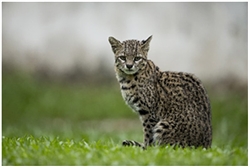 |
Geoffroy's Cat (Leopardus geoffroyi) LC
Geoffroy’s cat has the local common name of ‘gato de montes’, meaning cat of the mountains. It is mainly found in the Andes, with a preference for dense cover of many types. It is probably the most common felid in South America.
(Image Credit 00000-00571292 Sebastian Kennerknecht/Minden Pictures/FLPA)
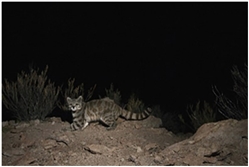 |
Andean Mountain Cat (Leopardus jacobita) EN
The distribution of the Andean cat is small and fragmented and linked to its main prey item of rodents (particularly chinchilla and vizcacha). The climate is extremefor this medium-sized felid (~74-85cm total length), with low temperatures and precipitation.
(Image Credit 00000-00571297 Sebastian Kennerknecht/Minden Pictures/FLPA)
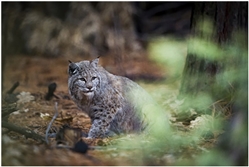 |
Bobcat (Lynx rufus) LC
Bobcats can be found across North America in a wide variety of habitats, so long as they provide cover and sites for dens. They are also flexible and less specialised in prey selection than their close relative Lynx canadensis.
(Image Credit 00000-00573921 Jaymi Heimbuch/Minden Pictures/FLPA)
 |
Northwest African Cheetah (Acinonyx jubatus ssp. hecki) CR
In northwest Africa, the cheetahs’ range has been significantly reduced (probably mainly due to hunting) and there is only certainty that they still exist in just four countries: Algeria, Niger, Benin and Burkina Faso. The total population is declining and likely to be fewer than 250 mature individuals.
(Image Credit 00000-00576410 Marion Vollborn, BIA/Minden Pictures/FLPA)
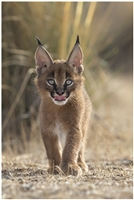 |
Caracal (Caracal caracal) LC
The caracal is found across Africa, central and south-west Asia into India, it prefers drier woodland and savanna. They hunt a wide variety of prey and can leap high to catch a bird that has just been flushed out from its cover.
(Image Credit 00000-00579267 Marion Vollborn, BIA/Minden Pictures/FLPA)
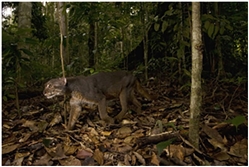 |
Borneo Bay Cat (Catopuma badia) EN
Little is known about this relatively rare felid that is endemic to Borneo. It is usually found in forests (preferably undisturbed) but not oil palm plantations and has reddish and grey colour phases. It is usually diurnal (active during the day).
(Image Credit 00000-00533938 Sebastian Kennerknecht/Minden Pictures/FLPA)
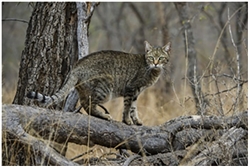 |
African Wild Cat (Felis silvestris lybica) LC
The Near Eastern wildcat is one of a number of subspecies of wildcat, that ranges from northern Africa through part of the Arabian Peninsula to the Caspian Sea. They are not found in tropical rainforest and rarely in true desert. Domestic cats are descended from wildcats. Other species are: F. silvestris silvestris European wild cats, and F. silvestris ornata Asiatic wild cat.
(Image Credit 00000-00560437 Pete Oxford/Minden Pictures/FLPA)
 |
African Golden Cat (Caracal aurata) VU
The African golden cat inhabits the forests of Equatorial Africa. They usually prey on rodents and squirrels but they have been observed hunting arboreal (tree) primates. They are hunted by leopards (Panthera pardus).
(Image Credit 00000-00560492 Sebastian Kennerknecht/Minden Pictures/FLPA)
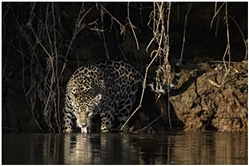 |
Jaguar (Panthera onca) NT
The jaguar is the largest cat in the Americas where it can be found throughout Central America, mainly in the Amazon basin. It has a more powerful bite than other felid of its size; whilst its short, strong limbs are better adapted to travelling through dense forest than running quickly across open spaces.
(Image Credit 00000-00568876 Luciano Candisani/Minden Pictures/FLPA)
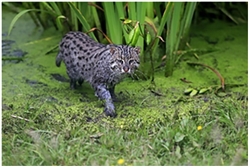 |
Fishingcat (Prionailurus viverrinus) VU
Found in South and Southeast Asia, despite its name, the fishing cat eats a variety of prey including rodents, birds and sometimes larger mammals like young deer. It can dive into water to catch prey using its webbed hind feet to swim leaving its front paws free to catch prey.
(Image Credit 10196-00140-249 Jurgen & Christine Sohns/FLPA)
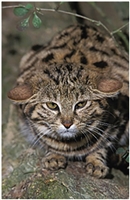 |
Black-footed Cat (Felis nigripes) VU
This South African cat is one of the world’s smallest (average 1.3-1.9kg). They like to make their den in hollowed-out, abandoned termite mounds where they rest during the day and then hunt at night, even when temperatures are as low as -8oC.
(Image Credit 10199-00006-235 Gerard Lacz/FLPA)
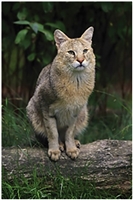 |
Jungle Cat (Felis chaus) LC
Jungle cats are native to Asia and are widespread, particularly in India and possibly Iran. Their average length is 50-94cm and are often found near water, in a wide range of habitats, where they will hunt, usually at night.
(Image Credit 10200-00026-249 Jurgen & Christine Sohns/FLPA)

